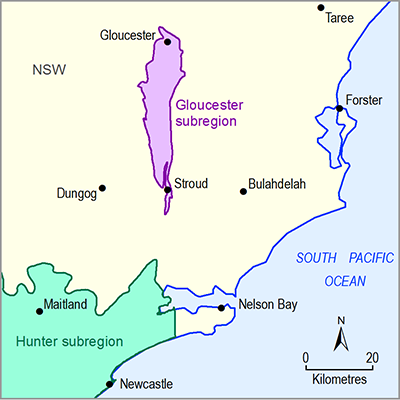Initially 10 sociocultural assets that are landscape water features (comprising 9 catchments and 1 estuary) were identified by the Hunter‑Central Rivers CMA. Following Mount et al. (2014), as these are all landscape water features having both ecological and sociocultural values, to avoid repetition of assets these are all included in the ecological asset classes, though the sociocultural information is retained for use in other bioregional assessment (BA) components such as the impact and risk analyses. Next, a search of the Australian Heritage database (Department of the Environment, 2014) uncovered 20 sociocultural assets comprising 20 elements. Finally, following the asset workshop held in Gloucester in June 2014, another 49 sociocultural assets (comprising 49 elements) were identified. Many (48 of 49) were obtained by spatially intersecting the PAE with the local environmental plans (LEPs ‑ statutory planning instruments as described in the Environmental Planning and Assessment Act 1979 (NSW)). The remaining single sociocultural asset (i.e., Allworth Community Swimming Pool/Baths located on lower Karuah River) was identified by the Great Lakes Council. Two other sociocultural assets provided post‑workshop by the Great Lakes Council (i.e., Booral Wharf and Karuah River Washpool (at Stroud Rd)) were already recorded in the LEP.
Table 19 shows the breakdown of sociocultural elements and assets by subgroup and class. Many of the sociocultural assets were derived from geographically intersecting the Australian Heritage database and the LEPs with the preliminary assessment extent (PAE) of the Gloucester subregion and are buildings located in the towns of Gloucester and Stroud. Due to these buildings being located away from the river network, it is anticipated that there will be negligible change in water availability and/or water quality impacting these assets due to coal‑related extractive industries.
Table 19 Classification of elements into sociocultural assets in the preliminary assessment extent (PAE) of the Gloucester subregion
|
Group |
Subgroup |
Class |
Number of elements |
Number of assets |
|
Sociocultural |
Cultural |
Heritage site |
66 |
66 |
|
Indigenous site |
0 |
0 |
||
|
Social |
Recreation area |
3 |
3 |
Only four of the sociocultural assets were found to be water‑dependent: (i) Port Stephens Estuary (which is the lower Karuah River), (ii) Booral Wharf, (iii) Karuah River Washpool (at Stroud Rd) and (iv) Allworth Community Swimming Pool/Baths. Three are clearly water features (see (i), (iii) and (iv) above), while Booral Wharf is classified as ‘historical ruins’ (gazetted in November 1999 as part of the Great Lakes Council Environmental Heritage) and is deemed to be water dependent because a change in the flow regime has the potential to damage the structure.
Initial conversations have been held with Indigenous knowledge holders in the Gloucester subregion to gain an understanding of Indigenous cultural water‑dependent assets. These discussions will continue over coming weeks and months. Where possible and appropriate, and with the agreement of Indigenous knowledge holders, Indigenous water‑related values will be incorporated into an updated water‑dependent asset register or incorporated into later technical products.

